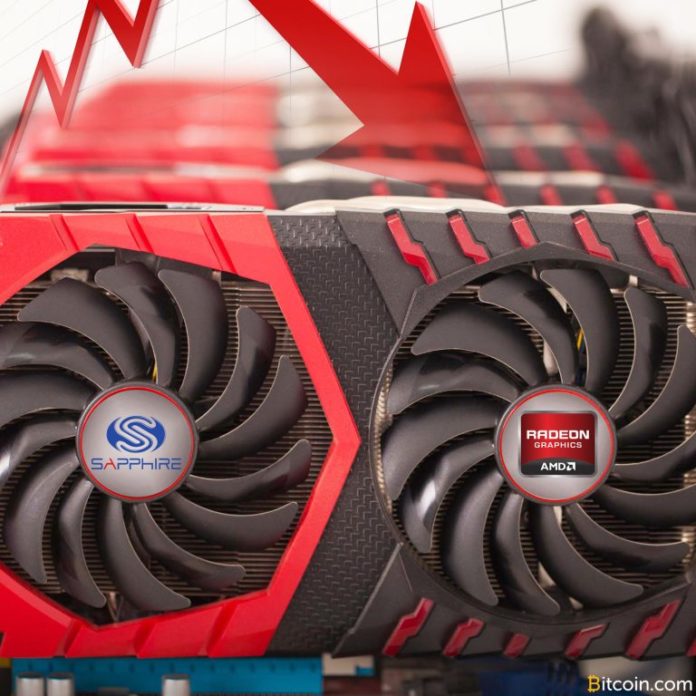
In The Daily this Saturday, Sapphire has designed a new graphics card suitable for mining the recently launched Mimblewimble cryptocurrency Grin. In other news related to the minting of digital coins, Taiwan Semiconductor Manufacturing Company has reported a significant decrease in its revenues from the mining segment, and some Ethereum miners have switched to Constantinople before the rescheduled hard fork.
Also read: Shapeshift Shares Compliance Requests, Grin Woos Bitcoin Maximalists
Sapphire to Offer Video Card Designed to Mine Grin
Hardware manufacturer Sapphire Technology has developed an exclusive version of its Radeon RX 570 video card. The new graphics processing unit (GPU) has 16 GB of GDDR5 memory instead of the standard 4 or 8 GB.
According to the Chinese tech news outlet Mydrivers, the card is not oriented toward gaming applications but cryptocurrency mining. Representatives of the company’s Hong Kong office explained the product has been designed to mine the new cryptocurrency Grin.

The privacy-centric crypto, which was launched this month, is based on the Mimblewimble protocol and uses the Cuckoo Cycle hashing algorithm that needs between 5.5 and 11 GB of memory. Sapphire believes the card’s 16 GB will significantly improve its performance in comparison to other mining chips.
The new GPU is based on Sapphire’s popular model RX 570 Nitro+ from which it took the two-slot cooling system with two fans, the Russian website 3dnews reported. The exact launch date for the video card is yet to be confirmed.
TSMC Reports ‘Big Drop’ in Mining Segment Revenue
Taiwan Semiconductor Manufacturing Company (TSMC) has recently published its Q4 2018 financial results, along with an earnings call transcript. The chip-producing giant has reported a significant drop in the revenue from the cryptocurrency mining sector last year.
The report does not quote the mining-specific data separately – rather, the company has released the information as part of its high-performance computing (HPC) segment. However, TSMC’s chief executive and vice chairman C.C. Wei said that while HPC, excluding mining, has grown slightly, “cryptocurrency is a big drop from 2018 to 2019.” According to the earnings call transcript, he added:
If we put the cryptocurrency together in the HPC, it’s a big drop. It’s almost a double-digit.
TSMC is a leading supplier of ASIC chips to Bitmain. The Chinese crypto mining giant has found itself under growing pressure during the bearish 2018. The Beijing-headquartered company recently suspended operations at a new mining facility it was building in Texas and closed down its research and development center in Israel.
Taiwan Semiconductor Manufacturing Company has reported a total business revenue of $9.4 billion in the last quarter of 2018, which represents a 2 percent increase on year-over-year basis. According to the company’s management, the Q1 2019 revenue is expected in the range of $7.3 – $7.4 billion.
ETH Miners Switch to Constantinople Before the Postponed Fork
A chain split has occurred on the Ethereum network following the rescheduling of the Constantinople hard fork. The upgrade was expected to be implemented at block 7,080,000 on Jan. 16, but hours before the event, on Jan. 15, developers issued an alert informing the community they were postponing the fork.

Apparently, not all Ethereum miners received the warning as some started mining the Constantinople chain and not the one with the majority consensus. The decision to call off the upgrade came after Ethereum core developers and the Ethereum security community were notified of potential vulnerabilities.
According to a blog post, the Constantinople-related issues have been identified by Chainsecurity. “We are investigating any potential vulnerabilities and will follow with updates in this blog post and across social media channels,” the developers said. They also asked node operators, crypto exchanges, miners, and wallet providers “to update to a new version of Geth or Parity before block 7,080,000.”
In a post on Medium, Chainsecurity detailed: “The upcoming Constantinople upgrade for the Ethereum network introduces cheaper gas cost for certain SSTORE operations. As an unwanted side effect, this enables reentrancy attacks when using address.transfer … or address.send … in Solidity smart contracts. Previously these functions were considered reentrancy-safe, which they aren’t any longer.”

The Constantinople hard fork has since been scheduled for block number 7,280,000 and is expected on or around Feb. 27, according to a tweet by developer Péter Szilágyi. “Will be a single fork on mainnet and a post-Constantinople-fixup fork on the testnets to get them back in line feature wise with the main network,” he explained.
What are your thoughts on today’s news tidbits? Tell us in the comments section.
Images courtesy of Shutterstock.
Want to create your own secure cold storage paper wallet? Check our tools section.
The post The Daily: Sapphire Develops GPU for Grin, TSMC Sees Drop in Mining Revenue appeared first on Bitcoin News.

Bitcoin.com is author of this content, TheBitcoinNews.com is is not responsible for the content of external sites.
Our Social Networks: Facebook Instagram Pinterest Reddit Telegram Twitter Youtube










